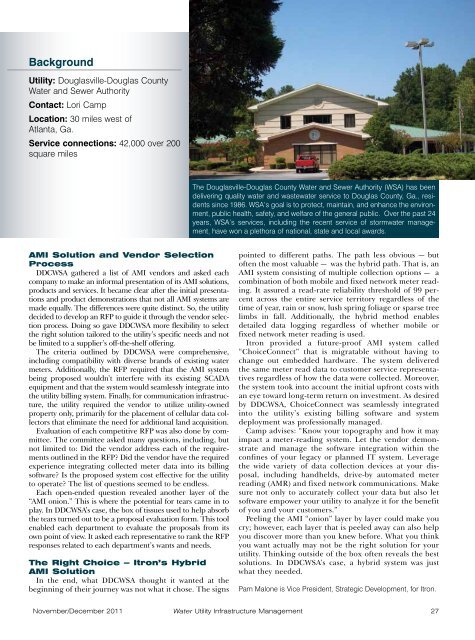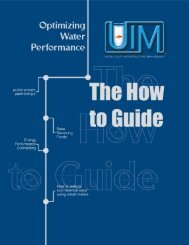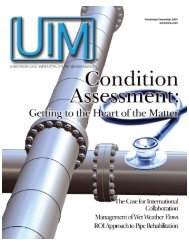Download - Water Utility Infrastructure Management
Download - Water Utility Infrastructure Management
Download - Water Utility Infrastructure Management
Create successful ePaper yourself
Turn your PDF publications into a flip-book with our unique Google optimized e-Paper software.
Background<br />
<strong>Utility</strong>: Douglasville-Douglas County<br />
<strong>Water</strong> and Sewer Authority<br />
Contact: Lori Camp<br />
Location: 30 miles west of<br />
Atlanta, Ga.<br />
Service connections: 42,000 over 200<br />
square miles<br />
The Douglasville-Douglas County <strong>Water</strong> and Sewer Authority (WSA) has been<br />
delivering quality water and wastewater service to Douglas County, Ga., residents<br />
since 1986. WSA’s goal is to protect, maintain, and enhance the environment,<br />
public health, safety, and welfare of the general public. Over the past 24<br />
years, WSA’s services, including the recent service of stormwater management,<br />
have won a plethora of national, state and local awards.<br />
AMI Solution and Vendor Selection<br />
Process<br />
DDCWSA gathered a list of AMI vendors and asked each<br />
company to make an informal presentation of its AMI solutions,<br />
products and services. It became clear after the initial presentations<br />
and product demonstrations that not all AMI systems are<br />
made equally. The differences were quite distinct. So, the utility<br />
decided to develop an RFP to guide it through the vendor selection<br />
process. Doing so gave DDCWSA more flexibility to select<br />
the right solution tailored to the utility’s specific needs and not<br />
be limited to a supplier’s off-the-shelf offering.<br />
The criteria outlined by DDCWSA were comprehensive,<br />
including compatibility with diverse brands of existing water<br />
meters. Additionally, the RFP required that the AMI system<br />
being proposed wouldn’t interfere with its existing SCADA<br />
equipment and that the system would seamlessly integrate into<br />
the utility billing system. Finally, for communication infrastructure,<br />
the utility required the vendor to utilize utility-owned<br />
property only, primarily for the placement of cellular data collectors<br />
that eliminate the need for additional land acquisition.<br />
Evaluation of each competitive RFP was also done by committee.<br />
The committee asked many questions, including, but<br />
not limited to: Did the vendor address each of the requirements<br />
outlined in the RFP Did the vendor have the required<br />
experience integrating collected meter data into its billing<br />
software Is the proposed system cost effective for the utility<br />
to operate The list of questions seemed to be endless.<br />
Each open-ended question revealed another layer of the<br />
“AMI onion.” This is where the potential for tears came in to<br />
play. In DDCWSA’s case, the box of tissues used to help absorb<br />
the tears turned out to be a proposal evaluation form. This tool<br />
enabled each department to evaluate the proposals from its<br />
own point of view. It asked each representative to rank the RFP<br />
responses related to each department’s wants and needs.<br />
The Right Choice — Itron’s Hybrid<br />
AMI Solution<br />
In the end, what DDCWSA thought it wanted at the<br />
beginning of their journey was not what it chose. The signs<br />
pointed to different paths. The path less obvious — but<br />
often the most valuable — was the hybrid path. That is, an<br />
AMI system consisting of multiple collection options — a<br />
combination of both mobile and fixed network meter reading.<br />
It assured a read-rate reliability threshold of 99 percent<br />
across the entire service territory regardless of the<br />
time of year, rain or snow, lush spring foliage or sparse tree<br />
limbs in fall. Additionally, the hybrid method enables<br />
detailed data logging regardless of whether mobile or<br />
fixed network meter reading is used.<br />
Itron provided a future-proof AMI system called<br />
“ChoiceConnect” that is migratable without having to<br />
change out embedded hardware. The system delivered<br />
the same meter read data to customer service representatives<br />
regardless of how the data were collected. Moreover,<br />
the system took into account the initial upfront costs with<br />
an eye toward long-term return on investment. As desired<br />
by DDCWSA, ChoiceConnect was seamlessly integrated<br />
into the utility’s existing billing software and system<br />
deployment was professionally managed.<br />
Camp advises: “Know your topography and how it may<br />
impact a meter-reading system. Let the vendor demonstrate<br />
and manage the software integration within the<br />
confines of your legacy or planned IT system. Leverage<br />
the wide variety of data collection devices at your disposal,<br />
including handhelds, drive-by automated meter<br />
reading (AMR) and fixed network communications. Make<br />
sure not only to accurately collect your data but also let<br />
software empower your utility to analyze it for the benefit<br />
of you and your customers.”<br />
Peeling the AMI “onion” layer by layer could make you<br />
cry; however, each layer that is peeled away can also help<br />
you discover more than you knew before. What you think<br />
you want actually may not be the right solution for your<br />
utility. Thinking outside of the box often reveals the best<br />
solutions. In DDCWSA’s case, a hybrid system was just<br />
what they needed.<br />
Pam Malone is Vice President, Strategic Development, for Itron.<br />
November/December 2011<br />
<strong>Water</strong> <strong>Utility</strong> <strong>Infrastructure</strong> <strong>Management</strong> 27








